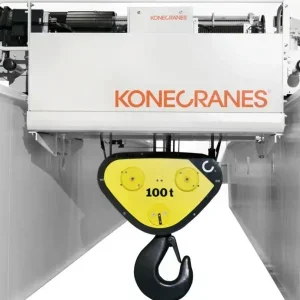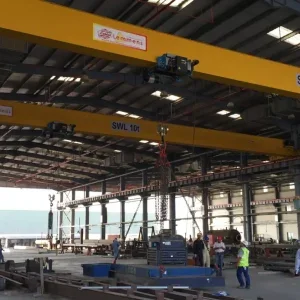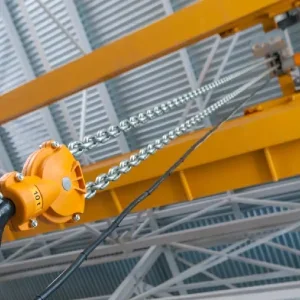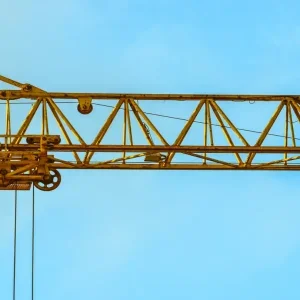On the site of the old Philadelphia Naval Yard, Kvaerner Philadelphia Shipyard Inc. is nearing completion – the first new shipyard to be built in the USA since World War II. Although a 700ft (213m) container vessel has begun construction, full-scale ship building operations are a year to 18 months away. When fully operational, the yard is expected to employ around 1,100 people.
The chosen supplier of 23 new cranes and one major crane retrofit, under a contract worth about $14m, was KCI Konecranes. To meet Kvaerner’s rigorous construction schedule Konecranes manufactured the cranes at factories in five countries on two continents.
A casualty of federal government cost-cutting, the Philadelphia Naval Yard was part of a round of military base closures in 1991. The facility was largely unused until early in 1998 when Finland-based Kvaerner, one of the world’s leading builders of special vessels such as cruise liners, chemical tankers, cable-laying ships and ice-reinforced vessels, committed to lease and renovate 40ha of the facility.
In a city where labour costs are among the highest in the USA, Kvaerner sought to control costs by controlling the length of the project. Heavy penalties would be imposed for missed deadlines, and installations would have to be fully coordinated with the building erection, an element outside the crane supplier’s control.
The turnkey challenge
Kvaerner concentrates its ship building operations on a small group of core activities, subcontracting non-core activities, with an emphasis on purchasing turnkey packages that minimise risk. For example, Kvaerner does not purchase a simple engine – the company instead contracts for a fully installed engine with all support systems working. It is the responsibility of the contractor to make sure everything works. So Konecranes had to secure its own contractors in Philadelphia to install the cranes.
According to Konecranes America chairman Tom Laughlin, KCI Konecranes faced fierce competition for the contract. “Kvaerner had more experience with German-based Demag because Demag had supplied a similar set of cranes for their Rostock yard, a recent project in Germany. But for Kvaerner, delivery was the major concern.” And what gave Konecranes the edge, he says, was its strong US presence, along with its Engineered Services Group and Crane Pro service network. And with the 23 new cranes needing to be built in several locations and then shipped to storage for installation when needed, Laughlin believes that Kvaerner also recognised Konecranes’ global as well as local, resources.
Kvaerner awarded the order to Konecranes in June 1998, with a tight four month delivery window from February to June 1999. The original order was for 27 cranes, later amended to 23 cranes, plus the modernisation. The cranes were constructed on parallel schedules at facilities around the world using Konecranes’ modular component system. Four of the cranes were built in Finland, two in France and five in Scotland. Twelve of the cranes came from North America – 10 were built at the Houston facility in the USA and the two largest in Canada.
Steve Kosir, now president of Konecranes America, was formerly vice president of operations for engineering and production at the Houston facility that built 10 of the cranes. “Safety and reliability were two prime considerations for the customer, which we met with proven KCI integrated solutions,” says Kosir. “All motions on all of the cranes were equipped with the KCI Dyna family Vector type frequency inverters for accurate positioning and safe load handling. KCI overload protection, load displays and KCI-designed magnet control packages, complete with magnets, lifting beams and battery backup systems added to safe and precise operation.” These systems were needed because Kvaerner has taken assembly-line techniques for automated, modular shipbuilding to a new level at the Philadelphia facility. Everything here is engineered to maximise return on labour investment. Kvaerner wanted to be able to build some of the largest modules ever attempted in the USA – up to 660t, to be exact – while minimising man hours spent on material handling. The cranes were designed to address this, using automation to manoeuvre larger modules with fewer man hours than less-modern yards. The 120t crane in the plate shop features two 60t torsion trolleys and one 80t conventional trolley for precise handling and turning of major ship modules, such as the heavy, reinforced double-bottom sections where void and ballast tanks are located. This enables Kvaerner to use its manpower to maximise output of other construction machinery and keep the ship building process moving.
For Konecranes, the 120t panel shop crane and the even larger 220t crane destined for the grand block shop represented a challenge in every aspect, from design and construction to shipping. In addition to their size, these larger cranes were technically complex.
According to Kosir, another element of challenge was juggling production and shipping to meet a delivery schedule that changed. The cranes were built on time, but because facility construction took longer than expected, the customer was not always ready to receive them.
Installation
Working conditions in Philadelphia are known to be among the most difficult in the USA, from a management perspective, because of deeply-ingrained boundaries between major craft lines, including electricians, ironworkers, operating engineers and Teamsters union members. Konecranes’ Engineered Services/Marine Projects manager Ed Johnston had to coordinate the various trades, refereeing disputes concerning overlapping responsibilities.
“We discovered the nuances of doing business in the northeast,” says Johnston. “For example, when we brought in a crane and unloaded it immediately, we could do that without a Teamster driver. But if the driver unhooked from the load, leaving a girder on a trailer, we needed to have a Teamster to hook it up and move it. Our goal was to have just one driver moving loads for us to keep costs down. When possible, we organised the loads out of Houston so that we could put the cranes up straight off the truck.”
A $1.4m retrofit
The major structural retrofit and relocation of an oversized Vianova plate-handling crane salvaged from Navy ship building operations was 8% to 10% of the total contract value. Destined for duty unloading of all of the steel plate coming into the yard from rail cars, the crane was first moved to a new location. Konecranes’ Engineered Services Group then cut and rebuilt the legs of the gantry to enable 40ft sections of material to be carried through the portal. The crane was completely reconditioned, adding a new plate-handling magnet spreader beam and replacing the operator cab with an automated radio control system. The new system featured the Dyna family of inverter controls.
Kvaerner later asked Konecranes to overhaul the festoon system as well. Johnston estimated that the crane was returned to like-new condition for about 60% of the cost of a new one.
Kosir sums up the lessons learned by Konecranes: “Teamwork was the key to our success, both internally within Konecranes as well as interfacing with the customer and all of the trades on site at the shipyard. We knew clearly going in that there would be tight demands on us for delivery and technical solutions. There were no surprises. Our advantage is a ‘virtual’ Konecranes engineering office all over the world operating 24 hours a day. We are all networked, and we work on the same technical platform everywhere. This project literally went around the globe on the Konecranes network before it was finished.” The client seems suitably appreciative of Konecranes’ efforts. John Graham, Kvaerner’s maintenance manager for the new yard, says: “The logistics of coordinating shipment and delivery from plants in five countries to our site and doing it in a timely fashion is a mind-boggling challenge.”






